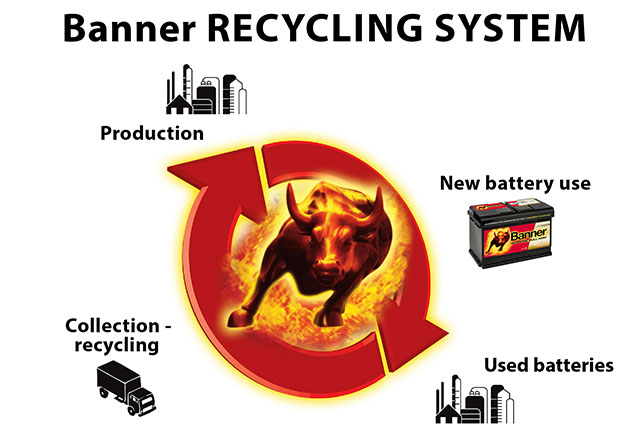Differing technologies, one objective
Banner experts explain
E-mobility is and will remain a hotly debated subject. For while the lead-acid battery has for many years been used successfully in both petrol- and diesel-driven vehicles, the lithium-ion battery for e-vehicles is still under public scrutiny. In fact, a great deal of research with regard to the safety and recyclability of this battery type remains to be completed and in the meantime, lead-acid technology can make a decisive contribution to decarbonisation.
Linz-Leonding, 26 January 2021. Diverse technologies are employed in the field of automotive and industrial batteries, and apart from the much discussed lithium version, there are also lead-, nickel- and sodium-based variants. All of these electrochemical systems possess their own individual characteristics, which qualify them for specific applications. For example, lead-acid technology has long been familiar as a 12 V starter and electrical system battery, while the lithium-ion battery replaces fossil fuels as a source of propulsion. However, as Thomas Bawart, Banner’s CTO, explains, “Combinations of 12 V lead-acid starter batteries and lithium-ion-based, high-voltage drive batteries are standard to the latest e- and hybrid vehicles, and this will remain the case in the coming years.” Lithium-ion technology can also be employed as starter and electrical system batteries, but the advantages of lead-acid types are evident at a glance:
Advantages of lead-acid batteries:
- A closed product cycle for virtually complete, environment-friendly recycling
- Decades of experience in the operational, research and further development fields
- User safety
- Additional utilisation as a slow discharge battery in the hobby and leisure area
- No memory effect, which allows repeated recharging irrespective of the discharge status
- An extremely robust and favourably priced design with low maintenance costs
- Temperature stability
Parallel to the proven lead-acid version, lithium-ion batteries are being employed increasingly as a power source. Indeed, they have already long proven their worth in millions of mobile devices. Moreover, owing to their lightness and the strength emanating from a high level of energy density, today they are being successfully utilised as starter, electrical system and vehicle batteries. In particular, their popularity is growing steadily in the racing and tuning scene, as well as for motorcycles, the premium sports car segment and in the hobby and leisure area.
Advantages of lithium batteries:
- Increased energy density and therefore high performance in a relatively small battery box
- Weight savings of up to 50 per cent as compared to lead-acid batteries
- Low self-discharge in combination with high performance after extended standstills
- High charging current and hence short charging procedures, although only with special charging devices
- A high number of possible charge cycles
- A memory effect that is not evident to the user
Disadvantages:
- Danger of fire
- Increased temperature instability
- Higher costs
- The highly problematic mining of rare earths (cobalt, nickel)
- Considerable water requirements in the world’s most arid regions

Considerable unexploited potential also remains with respect to the recycling of lithium-ion batteries. With the processes currently available, to date only cobalt, nickel and partially manganese can be recovered economically. Up to now, lithium has only been extracted in experimental pilot plants and therefore generally remains in slag (Source: European Automobile Club Newsletter, December – January 2021).
By contrast, a functional collection system exists for used lead-acid batteries and the treated material is returned to the production chain in new products. Workshops and sales outlets issue new batteries and collect the used ones in special containers for collection by Banner. The battery materials are then returned to the production cycle in a process that has already been in operation for many years. Consequently, lead-acid batteries have the highest collection ratio of all the recyclable goods on the market, including glass and paper.
Banner is facing up to the mobility challenges of tomorrow
As Austria’s only manufacturer of starter batteries, Banner has monitored the trend to e-mobility from its beginnings and has acted accordingly. Every e-vehicle requires a 12V battery for the supply of its electrical system and therefore with its absorbent glass mat (AGM) and enhanced flooded batteries (EFB) the company plays an important role with regard to sustainability in this regard.
Moreover, as Thomas Bawart concludes, “With our environment-friendly start-stop batteries we help to save considerable quantities of fuel and thus make a considerable contribution to decarbonisation, which is why we are continuing to work systematically on the further development of the next generation of traditional start-stop batteries. We have set ourselves the task of achieving further improvements relating to charging and power output by means of optimised cell design and various design measures.”
Photo: Banner’s recycling loop
Photo credit: © Banner GmbH, reprints free of charge. Specimen copy requested.

